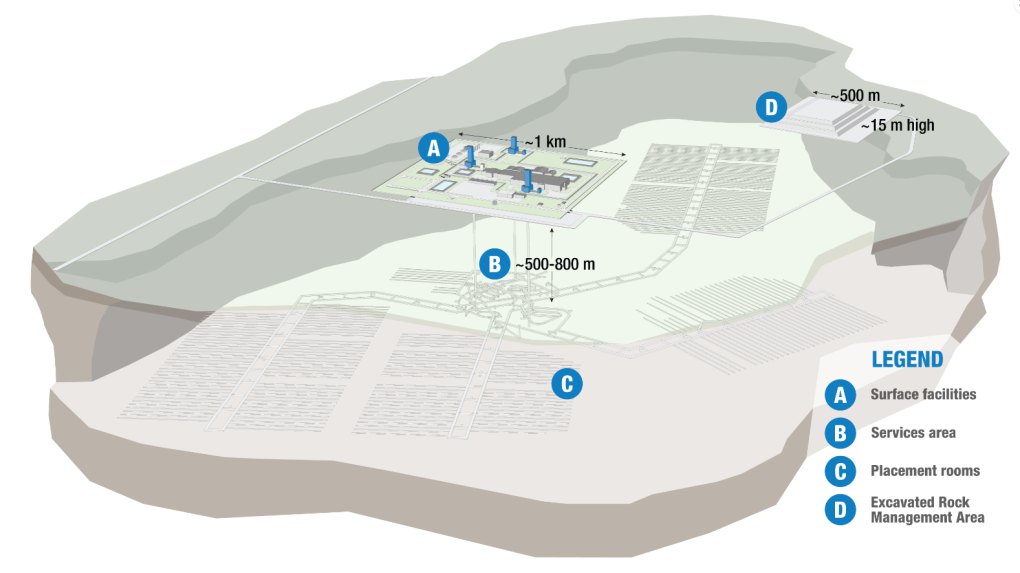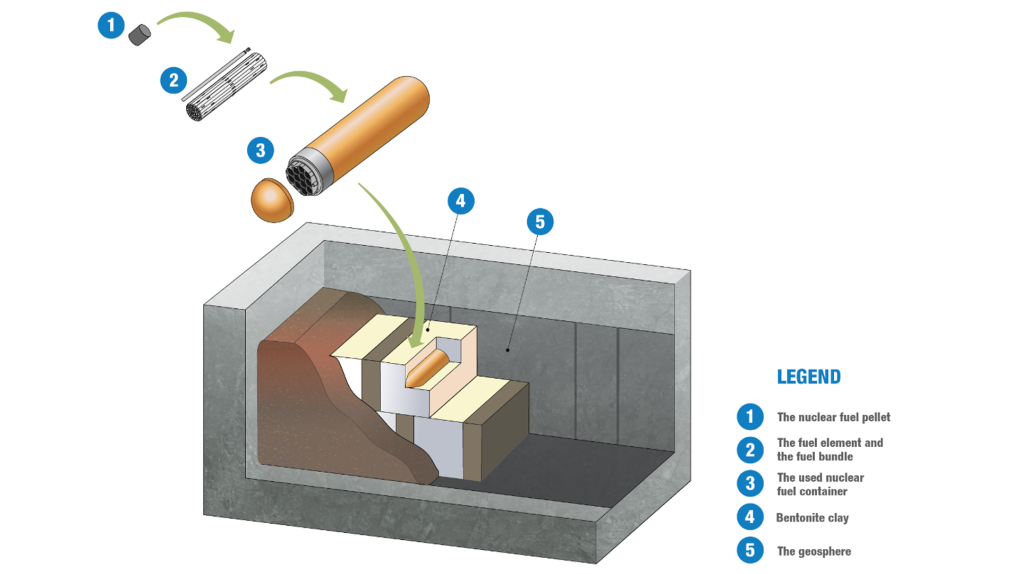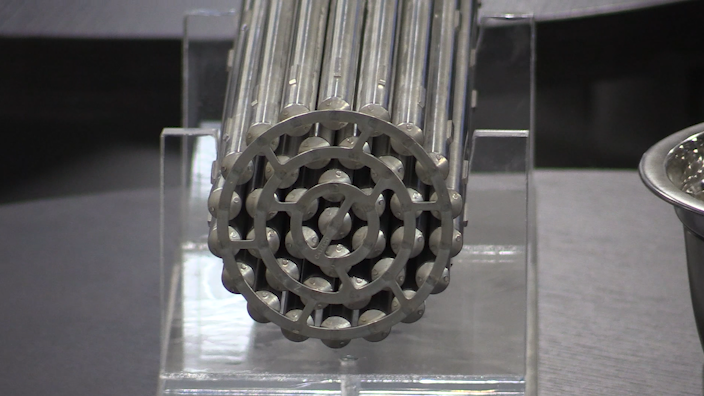Nuclear Waste Series: Is it safe to bury Canada’s used nuclear fuel underground, forever?
Jeff Binns is a corrosion scientist with the Nuclear Waste Management Organization (NWMO). He's spent years trying to figure out whether Canada's most radioactive nuclear waste can be permanently stored underground, forever.
"We couldn't be more confident that this is a safe system," said Binns.
Binns said the NWMO's plan to move over six million used nuclear fuel bundles (3.3 million currently in storage, 2.8 million more projected at end of Canada's nuclear life cycle) from their above ground temporary storage at Canadian nuclear generating sites to a permanent underground facility employs a multiple barrier system, or a "belts and suspenders approach," as he calls it.
First, 48 radioactive fuel bundles at a time will be moved from their current above ground containers into copper-lined, carbon steel containers or tubes for strength and corrosion protection.
Then, the containers will be sealed in bentonite clay boxes, which will then be backfilled with granular bentonite clay once inside the rock caverns drilled 550-650 metres underground.
Binns said the granular bentonite will swell when wet, ultimately making it harder for water to reach the containers.
"If water can't access the container, the container can't corrode because water is required for that. If the container can't corrode, you can't get access of the environment to the used fuel itself, which means the use fuel can't actually leave the DGR," said Binns.
 Conceptual drawing of the proposed layout for Canada's first permanent nuclear waste storage facility. (Source: Nuclear Waste Management Organization)
Conceptual drawing of the proposed layout for Canada's first permanent nuclear waste storage facility. (Source: Nuclear Waste Management Organization)
Binns said 115,000 thousand containers or tubes would be housed in the underground facility, known as a Deep Geological Repository, or DGR.
"A deep geological repository is a passive system where you build the deep geological repository and place the fuel inside it. Then, you backfill the repository and you will have some follow up monitoring, but you are then able to walk away," said Binns.
It's that final part that concerns many opponents of the project – abandonment.
"When you're looking after something, you don't abandon it. You know, you don't leave a baby in the field, walk away from it and say, ‘Stay there.’ It's managed. So, the point is that many people believe that this material is so dangerous that it should not be put beyond human control," said Gordon Edwards, director of the Canadian Coalition for Nuclear Responsibility.
NWMO projections show after all the waste is underground, there will be a 50 to 70 year monitoring period, followed by a 20 to 25 year decommissioning phase, and then the plan is to walk away from the entire underground facility.
 Conceptual drawing of the Multiple Barrier System that would be used for Canada's first permanent nuclear waste storage facility. (Source: Nuclear Waste Management Organization)
Conceptual drawing of the Multiple Barrier System that would be used for Canada's first permanent nuclear waste storage facility. (Source: Nuclear Waste Management Organization)
"The whole concept of abandoning the waste is basically for the convenience of the industry, because they want to walk away from it. They want to eventually say, ‘This is not my problem anymore, this is your problem.’ We believe that that's unethical. It's unscientific, it's unsound, and it's unfair," said Edwards, who joined renowned environmentalist David Suzuki at an event panning the nuclear waste burial plan earlier this month in Teeswater.
But Binns said it's the science and modules they've run that gives him and others confidence that permanent underground storage is the right thing to do.
"The real question we need to ask, is it safe to leave it where it is? And I believe the answer's no, not long term. Like we're talking a million years," said Municipality of South Bruce Mayor Mark Goetz.
"Each level of safety has a very, very low chance of failure in and of itself. And when you stack those up on top of each other, it's just an exceedingly low chance of failure. And we just have an incredible amount of confidence in the safety of the design," said Binns.
In Part 3 of your nuclear waste series, we'll talk about the impending vote, and what happens if less than half of South Bruce's 4311 registered voters cast a ballot in the community's DGR referendum, and what role the Saugeen Ojbway Nation plays in the project's fate.
 An example of a used nuclear fuel bundle at the Nuclear Waste Management Organization Demonstration Centre near Oakville in May 2024. (Scott Miller/CTV News London)
An example of a used nuclear fuel bundle at the Nuclear Waste Management Organization Demonstration Centre near Oakville in May 2024. (Scott Miller/CTV News London)
CTVNews.ca Top Stories

Frozen waffles from Whole Foods join Canadian recall list over listeria concerns
Whole Foods Market is joining the growing list of brands whose frozen waffles have been recalled in Canada this week because of possible listeria contamination.
Trump says he's open to eliminating income taxes as he pushes sweeping tariff proposals on podcast with Joe Rogan
Former U.S. president Donald Trump said on Joe Rogan’s podcast Friday that he would be open to eliminating income taxes, while pushing his sweeping tariff proposal and praising the economic policies of the late 19th century.
Lawsuit alleges Ontario man died after given 10 times prescribed dose in hospital
Angela Salvatore had been away from her father's hospital bedside for just over an hour when she says she got a frantic call from a nurse, pleading with her to calm him down.
What we know about the Canadians busted in an international drug ring led by a former Olympic athlete
Canadian Ryan James Wedding finished in 24th place in the parallel giant slalom at the 2002 Winter Games in Salt Lake City, but the snowboarder wouldn’t go on to improve his results in Torino four years later.
'Did he live? Did he die?': A decades-old mystery stretching from Manitoba to Ireland
The mystery of a 100-year-old letter sent from Manitoba to Ireland is slowly unraveling thanks to the work of one amateur sleuth.
How will the U.S. election affect the way Canadians vote?
As months, become weeks, become days left before this U.S. election cycle comes to an end, here's a look at what each outcome might mean for Canadian politics.
She connected on Instagram with a guy who lived in another country. Then they decided to meet up
In early 2018, Amanda and Sunil started chatting, messaging back and forth on Instagram, introducing themselves and talking a little about their lives. Fast forward to August 2018, the couple got engaged on vacation in Thailand and a year later, after Amanda moved to India, got married.
Here's what buyers should know before making a used car purchase in Canada
Based on initial appearances, there are signs indicating the automobile industry is in healthy shape – for now.
'If it were me, I'd be leaving': Longtime Liberal New Brunswick premier Frank McKenna on whether Trudeau should go
Former New Brunswick Liberal premier Frank McKenna says if he were in Prime Minister Justin Trudeau’s shoes, at this point in the government’s mandate, he would step down.































